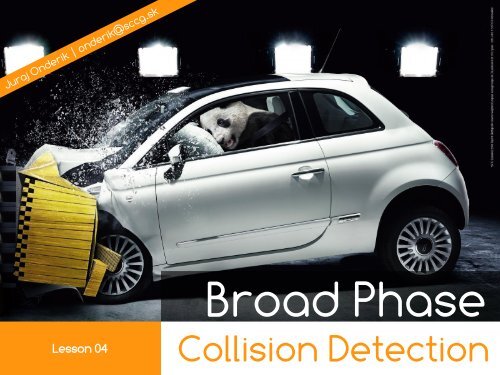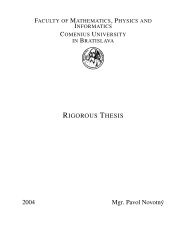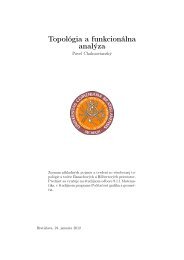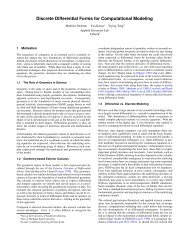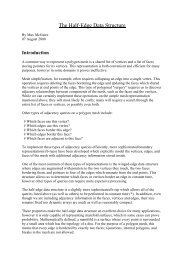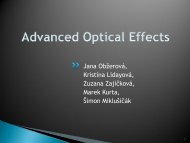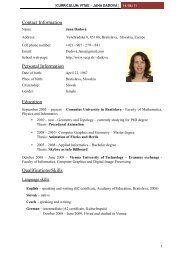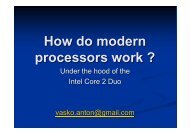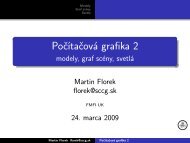Collision Detection
Collision Detection
Collision Detection
You also want an ePaper? Increase the reach of your titles
YUMPU automatically turns print PDFs into web optimized ePapers that Google loves.
Juraj Onderik | onderik@sccg.skBroad PhaseLesson 04<strong>Collision</strong> <strong>Detection</strong>
Lesson 04 Outline <strong>Collision</strong> <strong>Detection</strong> overview Hierarchical grids and Spatial hashing Sweep and Prune and Radix Sort Pair management – a practical guide Demos / tools / libs
<strong>Collision</strong> <strong>Detection</strong> Overview <strong>Collision</strong> detection (CD) means Calculate when and where are objects overlapping. General taxonomy of algorithms Static / Pseudo-dynamic / Dynamic Stages of CD algorithms Broad Phase / (Mid Phase) / Narrow Phase Algorithm strategies Spatial partitioning / Bounding volume hierarchies /Coordinate sorting / Feature tracking / Signed distancemaps …
Broad Phase Approximate (broad) collision detection phase. Principles Quickly find pairs of objects which are potentially (probably)colliding. Reject pairs of objects which are distant to each other. Techniques Uniform Spatial partitioning (Hierarchical grids) Complex Spatial partitioning (dynamic BSP, kd trees) Coordinate sorting (Sweep and prune, range search) Difficult to parallelize (GPU not friendly)
Mid Phase Mid (refinement) collision detection phase Principles Refine pairs from broad phase, simplify the work of narrowphase Techniques Preprocess complex geometry into Bounding VolumeHierarchies Decompose non-convex objects into convex parts Axis Aligned Bounding Boxes, Oriented Bounding Boxes,k-Discrete Orientation Polytopes, Swept Sphere Volumes... Usually good for parallelization (GPU friendly)
Narrow Phase Exact (Narrow) <strong>Collision</strong> detection phase. Principles Given a list of potential colliding pairs of objects find exacttime and geometry features (vertices, edges, faces) whereobjects penetrate (intersect). Reject all non-colliding object pairs. Techniques Bounding volume hierarchies (AABB, OBB, kDOP …) Coherent feature tracking (GJK, V-Clip) Signed distance map queries (2d/3d bitmap collisions) Naturally suitable for parallelization (GPU friendly)
<strong>Collision</strong> <strong>Detection</strong> Phases Broad Phase Find potentialpairsPotential collidingpairs
<strong>Collision</strong> <strong>Detection</strong> Phases Broad Phase Find potentialpairs Mid Phase Refine pairsPotential collidingpairsRemoved pairs
<strong>Collision</strong> <strong>Detection</strong> Phases Broad Phase Find potentialpairs Mid Phase Refine pairs Narrow Phase Find exactcollisionsPotential collidingpairsRemoved pairsExact collidingpairs
Hierarchical GridsSpatial Hashing
Uniform Grid – Principle Define a uniform grid with cell size s For each point p = (x,y,z) we can findcorresponding cell c = (i,j,k) = T(p) Tiling function T(p) = ([x/s], [y/s], [z/s])sys(i,j)(x,y)x
Uniform Grid – Principle Insert object (ID=1) into grid and store it's ID intooverlapping cells based on its AABBsys1111 1x
Uniform Grid – Principle Insert object (ID=1) into grid and store it's ID intooverlapping cells based on its AABB Insert object (ID=2) into grid …sy2 22s112221 1;222x
Uniform Grid – Principle Insert all objects into grid and store IDs into cells Orange cell has only one ID Blue cells contain more Ids - define colliding pairs Colliding pairs: (1-2),(1-4),(4-5)sy332 22s3 3 13 25 4;5412255 41;4 1;2224;54x
Uniform Grid – AddBox We want to add new object “A” into grid Calculate AABB(A) = (A x-, A y-, A z-, A x+, A y+, A z+) of “A” Calculate Cell(A) = (A i-, A j-, A k-, A i+, A j+, A k+) For each cell within (A i-, A j-, A k-) and (A i+, A j+, A k+) For each ID stored in the cell create pair (ID k, ID) Add ID of object from the list of IDs (check duplicates)
Uniform Grid – RemoveBox We want to remove existing object from grid Calculate AABB(A) = (A x-, A y-, A z-, A x+, A y+, A z+) of “A” Calculate Cell(A) = (A i-, A j-, A k-, A i+, A j+, A k+) For each cell within (A i-, A j-, A k-) and (A i+, A j+, A k+) For each ID stored in the cell remove pair (ID k, ID) Remove ID of object from the list of IDs
Uniform Grid – UpdateBox Object has moved - we need to update it's AABBand corresponding cells Simple approach: call RemoveBox, than AddBox Not efficient for larger and coherent objects – many cellshas not changed their state (no add, no remove) Effective approach: Find quickly only cells where we need to add/remove ID
Uniform Grid - Summary Pros Simple algorithm – easy to implement Fast in special cases – only particles (small dynamic objects)and static (large) environment Cons how to find optimal grid size → problem with large vs smalldynamic objects (hierarchical grid) Large 3d gird → huge amount of memory (spatial hashing) Slow grid update for large objects Accuracy depends on the largest resolution
Hierarchical Uniform Grid Suppose 4 uniform grids with 2kresolutions Grid-0: cell size s 0= 1/2 0 = 1.000 Grid-1: cell size s 1= 1/2 1 = 0.500 Grid-2: cell size s 2= 1/2 2 = 0.250 Grid-3: cell size s 3= 1/2 3 = 0.125s 0s 30123
Hierarchical Uniform Grid - Principle Find resolution of object “C”: Res(C) = 3 Cell sizes in grids: S = (s 0,s 1, … ,s k) Object box: AABB(C) = (C x-, C y-, C z-, C x+, C y+, C z+) Object size: Size(C) = Max(C x+- C x+-, C y+- C y+-, C y+- C y+-) Object resolution: Res(C) = i a
Hierarchical Uniform Grid - Principle Insert “C” into grid-3Cs 0s 30123CCC
Hierarchical Uniform Grid - Principle Insert “C” into grid-3 Insert “C” into grid-2Cs 0s 3012CC3CCC
Hierarchical Uniform Grid - Principle Insert “C” into grid-3 Insert “C” into grid-2 Insert “C” into grid-1Cs 0s 301C2CC3CCC
Hierarchical Uniform Grid - Principle Insert “C” into grid-3 Insert “C” into grid-2 Insert “C” into grid-1 Insert “C” into grid-0Cs 0s 30CD1C2CC3CCC
Hierarchical Uniform Grid - Principle Insert other objects into grids Build ID sets in cells Mark IDs “bold” which represent the resolution ofobjectABCDEF0ABCDDEFF1A ABCD DE2BBCs 0s 3CE3C C EA B C DE F
Hierarchical Uniform Grid - Principle During insertion report all ID pairs within each cellwhich are either “bold” x “regular” or “bold” x“bold” IDs Cell (AB) has only one pair: A-B Cell (DEF) has pairs: D-F and E-F (D-E is not a pair !)ABCDEF0ABCDDEFF1A ABCD DE2BBCs 0s 3CE3C C EA B C DE F
Hierarchical Uniform Grid - Methods AddBox(A) Calculate AABB(A), resolution r = Res(A), add box into all grids(0 to r), report pair (A-A k) only if grid resolution isMin(Res(A), Res(A k)) RemoveBox Calculate AABB(A), resolution r = Res(A), remove box from allgrids (0 to r), remove pair (A-A k) only if grid resolution isMin(Res(A), Res(A k)) UpdateBox Since objects ID are stored only in grids with equal or largerresolutions as Res(A) – no need for optimizing update –simply RemoveBox than AddBox every modified object
Hierarchical Uniform Grid - Summary Pros Handle small and large dynamic objects No optimal grid size True linear time broad phase algorithm Cons More memory (usually 2 times more) Must update (hash) more grids for each object Accuracy depends on the largest resolution Constant Update → Linear time complexity Assuming R = (s+/ s - ) = largest / smallest AABB size is constant We need k = log(R) grids – is constant One object marks O(log R) cells – is constant Add/Remove/Update - are constant → time complexity is O(n)
Spatial Hashing Motivation: large grids are usually very sparse –we need to store data only for non-empty cells –but we need fast O(1) access based on (x,y,z) Given point p=(x,y,z) laying within cell c=(i,j,k) wedefine spatial hashing function as hash(i,j,k) = (ip 1xor jp 2xor jp 3) mod n Where p 1, p 2, p 3are large prime numbers and n isthe size of hash table Hash collision are solved with buckets
Sweep & Prune
Sweep-And-Prune (SAP) Broad phase collision detection algorithm basedon Separating Axes Theorem. Pros Suitable for physically based motions Exploits spatial and temporal coherence Practical average O(n) broad phase algorithm Cons Uses bad fitting axis-aligned boxes (AABB). Not efficient for complex scenes with prolong objects Too many collisions for high-velocity objects
Separating Plane Theorem Two convex objects do NOT penetrate (areseparated) if and only if there exists a(separating) plane which separates them i.e. first (second) object is fully above (below) this plane.Separating plane
Separating Axis Theorem Two convex objects do NOT penetration (areseparated) if and only if there exists a(separating) axis on which projections of objectsare separated i.e. Intervals formed by minimal and maximal projections ofobjects do not intersect.Separating planeSeparatingAxis
Separating Duality Principle For Convex objects Separating Plane Theorem (SPT) Separating Axes Theorem (SAT) SAP and STP are equal (dual) ! Separating plane and separating axis are perpendicularSAP STP
SAP – Algorithm Principle Suppose a scene with 5 (not necessarily convex)objectsyx
SAP – Algorithm Principle Fit each object into its smallest enclosing AABB Label boxes as : 1, 2, 3, 4, 5 according to theassociated objects.y3 251 4x
SAP – Algorithm Principle Project AABBs onto axis X. Form list of intervals of minimal and maximalprojections on X axis.y3 251 4x
SAP – Algorithm Principle Project AABBs onto axis Y. Form list of intervals of minimal and maximalprojections on Y axis.y3 251 4x
SAP – Algorithm Principle Sort list of projections (limits) on X axis. Sort list of projections (limits) on Y axis.y...y 3y 23 21 45y 1xx 1x 2x 3x 4x 5x 6x 7x 8x 9x 10
SAP – Algorithm Principle Limits are marked as min (green) and max (blue)for associated AABB.y3 251 4x 1x 2x 3x 4x 5x 6x 7x 8x 9x 10x
SAP – Algorithm Principle Sweep X-limits from first to last while building setof open intervals. When adding new min-limit to the set, reportpotential collision pair between all boxes from setand the new box.y3 251 4x 1x 2x 3x 4x 5x 6x 7x 8x 9x 10x
SAP – Algorithm Principle Open interval set example: (), (1), (1;3), (1), (1;4), (4), (), (5), (), (2), () Reported pairs: (1-3) and (1-4)y3 251 4x 1x 2x 3x 4x 5x 6x 7x 8x 9x 10x
SAP – Algorithm Principle Do the same on Y-Axis: Set: (), (4), (4;1), (4), (4;5), (5), (5;2), (5;2;3), (2;3), (2), () Pairs: (1-4), (4-5), (5-2), (5-3), (2-3)y3 251 4x
SAP – Algorithm Principle Find common pairs in all swept directions i.e. Real intersecting AABB pairs = SetX ^ SetY Pairs = SetX ^ SetY = { (1-4) }y3 251 4x
SAP - Summary To achieve linear time O(n) complexity in averagecase we must Move objects in a coherent fashion (physical motion) Use incremental sort of limits. Due to coherence most oflimits are sorted. Insert sort needs only constant swaps. Implement an efficient “pair management” i.e. fast setintersection of axis pair sets (Pairs = SetX ^ SetY ^ SetZ) Problems Since objects tend to settle down (usually along Z-axis)during the simulation, large interval clustering can happen
SAP – Incremental Update Reported pairs: (1-3) and (1-4) Suppose object 5 moves righty3 251 4x 1x 2x 3x 4x 5x 6x 7x 8x 9x 10x
SAP – Incremental Update Reported pairs: (1-3) and (1-4) Suppose object 5 moves right End limit x 8pass over x 9breaking the order In this case we report new pair (2-5)y3 251 4x 1x 2x 3x 4x 5x 6x 7x 9x 8x 10x
SAP – Incremental Update Select moving objects and update theirs limits When a start limit moves right andpasses over start limit – report nothingpasses over end limit – remove pair When a start limit moves left andpasses over start limit – report nothingpasses over end limit – add pair When an end limit moves right andpasses over start limit – add pairpasses over end limit – report nothing When an end limit moves left andpasses over start limit – remove pairpasses over end limit – report nothing
SAP – Incremental Update Limit swap casesAdd Add Remove RemoveNothing Nothing Nothing Nothing
Pair Managementa practical guide
Pair Management An ID pair is defined as (ID 1, ID 2) Pair Manager is a data structure allowing quickly Adding new pair in O(1): AddPair(ID 1, ID 2) Removing an existing pair in O(1): RemovePair(ID 1, ID 2) Finding an existing pair in O(1): FindPair(ID 1, ID 2) Enumerating all pairs in O(n): GetPairs() Trivial approach is to use big matrix to store pair infos - just look at (ID 1, ID 2) item simple list to store set of active pairs. Huge amount of memory, pair list update can be slow Can be efficient for < 1000 objects (matrix size 10002!!!)
Efficient Pair Management Use spatial (2d) hashing: h = hash(ID 1, ID 2) = (ID 1*p1 + ID 2*p2) mod N Use array bag structure to hold pairs Preallocate “capacity” of data (usually 2 x length) AddPair – stores new pair at the end of array (can resize) RemovePair – move last pair to the removed index – fill thehole Point from hash table to pair list Chain pairs when hash collision occurs
Efficient Pair Management In hash table we store pointer to first pair in thehash collision chain (length k) – should be as smallas possible. When k > K (constant) we resize hashtable (rehash all pairs). Operations are O(k)=O(1)ID 1Hash tableID 2 (ID1 , ID 2) hash(ID 1,ID 2)Pair arrayVirtual ID pair matrixHash collision chain
Demos / tools / libs
Demos / tools / libs Free Open Source Libraries: Bullet Physics Library: http://www.bulletphysics.org Bullet collision detection frameworkhttp://bulletphysics.org/mediawiki-1.5.8/index.php/CDTestFramework Box2D: http://www.box2d.org/ Chipmunk: http://howlingmoonsoftware.com SOFA: http://www.sofa-framework.org/ Tokamak: http://www.tokamakphysics.com
theendthat was enough...


